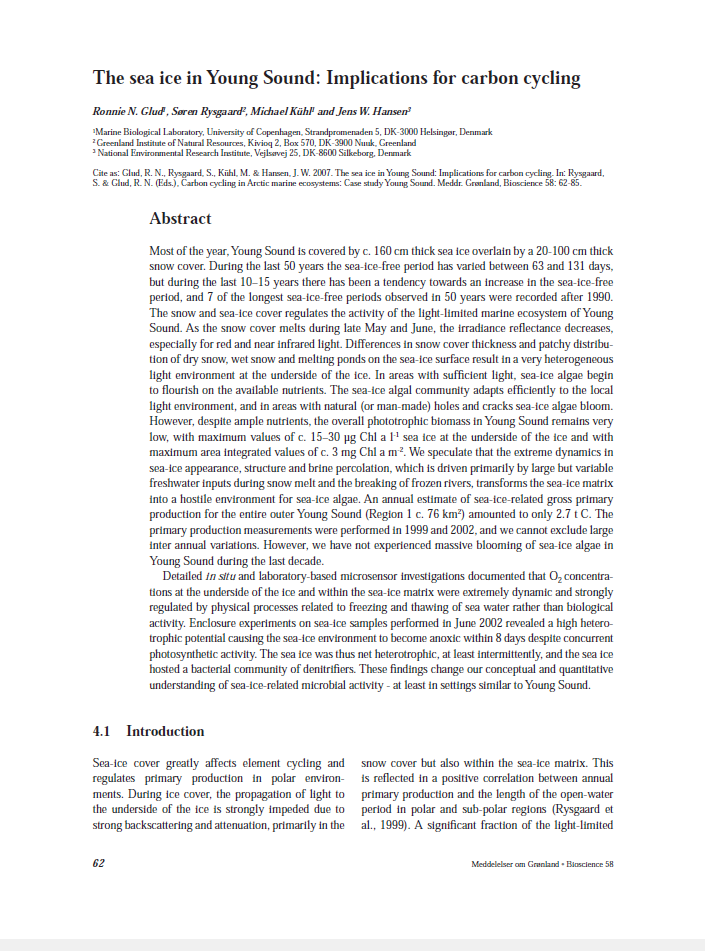The sea ice in Young Sound: Implications for carbon cycling
DOI:
https://doi.org/10.7146/mogbiosci.v58.142641Abstract
Most of the year, Young Sound is covered by c. 160 cm thick sea ice overlain by a 20-100 cm thick snow cover. During the last 50 years the sea-ice-free period has varied between 63 and 131 days, but during the last 10–15 years there has been a tendency towards an increase in the sea-ice-free period, and 7 of the longest sea-ice-free periods observed in 50 years were recorded after 1990.
The snow and sea-ice cover regulates the activity of the light-limited marine ecosystem of Young Sound. As the snow cover melts during late May and June, the irradiance reflectance decreases, especially for red and near infrared light. Differences in snow cover thickness and patchy distribution of dry snow, wet snow and melting ponds on the sea-ice surface result in a very heterogeneous
light environment at the underside of the ice. In areas with sufficient light, sea-ice algae begin to flourish on the available nutrients. The sea-ice algal community adapts efficiently to the local light environment, and in areas with natural (or man-made) holes and cracks sea-ice algae bloom.
However, despite ample nutrients, the overall phototrophic biomass in Young Sound remains very low, with maximum values of c. 15–30 μg Chl a l-1 sea ice at the underside of the ice and with maximum area integrated values of c. 3 mg Chl a m-2. We speculate that the extreme dynamics in sea-ice appearance, structure and brine percolation, which is driven primarily by large but variable
freshwater inputs during snow melt and the breaking of frozen rivers, transforms the sea-ice matrix into a hostile environment for sea-ice algae. An annual estimate of sea-ice-related gross primary production for the entire outer Young Sound (Region 1 c. 76 km2) amounted to only 2.7 t C. The primary production measurements were performed in 1999 and 2002, and we cannot exclude large
inter annual variations. However, we have not experienced massive blooming of sea-ice algae in Young Sound during the last decade.
Detailed in situ and laboratory-based microsensor investigations documented that O2 concentrations at the underside of the ice and within the sea-ice matrix were extremely dynamic and strongly regulated by physical processes related to freezing and thawing of sea water rather than biological activity. Enclosure experiments on sea-ice samples performed in June 2002 revealed a high heterotrophic potential causing the sea-ice environment to become anoxic within 8 days despite concurrent photosynthetic activity. The sea ice was thus net heterotrophic, at least intermittently, and the sea ice hosted a bacterial community of denitrifiers. These findings change our conceptual and quantitative understanding of sea-ice-related microbial activity - at least in settings similar to Young Sound.

Downloads
Published
Issue
Section
License
Coypyright by the authors and the Commision for Scientific Research in Greenland / Danish Polar Center/Museum Tusculanum Press as indicated in the individual volumes. No parts of the publications may be reproduced in any form without the written permission by the copyright owners.

